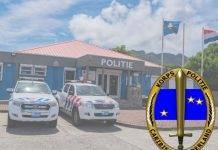PHILIPSBURG, Sint Maarten — As part of the Dutch Caribbean Nature Alliance Save our Sharks Project a second tiger shark has been tagged in the territorials waters of Sint Maarten with a satellite tracking device. A Wildlife Computer SPOT (Smart Position or Temperature Transmitting) satellite tag was attached to the first dorsal fin of a sub-adult tiger shark late in December. These tags transmit to satellites, allowing the sharks to be tracked through the ARGOS satellite system for up a number of years.
The first tagged tiger shark on St. Maarten, tagged in the fall of 2018, followed a migration track along the Aves ridge, a ridge in the Eastern Caribbean Sea of about 500 km in length probably of volcanic arc origin.The Foundation hopes that the recently tagged shark, called ‘Irma’ will also provide valuable data of the migration patterns of sharks i the wider Caribbean Sea.
“The preliminary data we have been receiving is starting to show some interesting results in terms of the migratory patterns of tiger sharks in the Eastern Caribbean Sea. Not only is this data important but it is also critical for the transboundary management of a marine species critical to the health of our Caribbean Sea. Sharks are apex predators and as such keep the ocean food chain healthy, a food chain which in turn supports regional fisheries.
With recent shark finning and fishing activities occurring in the wider Caribbean it behoves nation states in the Caribbean to establish a Wider Caribbean Management Plan for the species,” commented Tadzio Bervoets, Project Manager for the Dutch Caribbean Alliance Save our Shark Project.
Sea fairy, the first shark which was equipped with a satellite tag in this region, provided researchers with a wealth of location and movement information. She stayed the first months around St Maarten while doing forays to Anguilla, St Barths, Saba and the Saba Bank. In May 2017 Sea fairy migrated south following the Aves ridge and subsequently headed to Puerto Rico and Dominican Republic. The last location received for Sea Fairy was close to Puerto Rico.
“Sea fairy’s movement patterns may indicate a nursing area for tiger sharks around St Maarten, spending their juvenile years in sand and seagrass habitat before migrating around the Caribbean when large enough in size and maturity. It is interesting to see migration routes following the Aves ridge, which may supply the sharks with an abundant food source” stated Nature Foundation’s Project Officer Melanie Meijer zu Schlochtern.
Nature Foundation Staff are currently in Aruba to assist researchers there with researching thier shark populations; “This research will improve our understanding of the life characteristics of sharks and will provide knowledge about the population structure, abundance and migration of sharks in the Caribbean” explained Melanie Meijer zu Schlochtern.
The DCNA Save Our Sharks Project, funded by the Dutch National Postcode Lottery, has placed the focus on the conservation of sharks and rays in both the Caribbean and European part of the Kingdom of the Netherlands. The project has used science, education and community outreach and lobbying to establish shark sanctuaries, initiate science programs, and educate the public on the importance of sharks in the wider Caribbean; “We need to have more research initiatives so that we can get a better idea on the status of the species, their migratory patterns and their local distribution in the wider Caribbean. Sharks are critical to the health of the Caribbean Sea but are also one of the most threatened Large Marine Species on the planet,” concluded Bervoets.






























